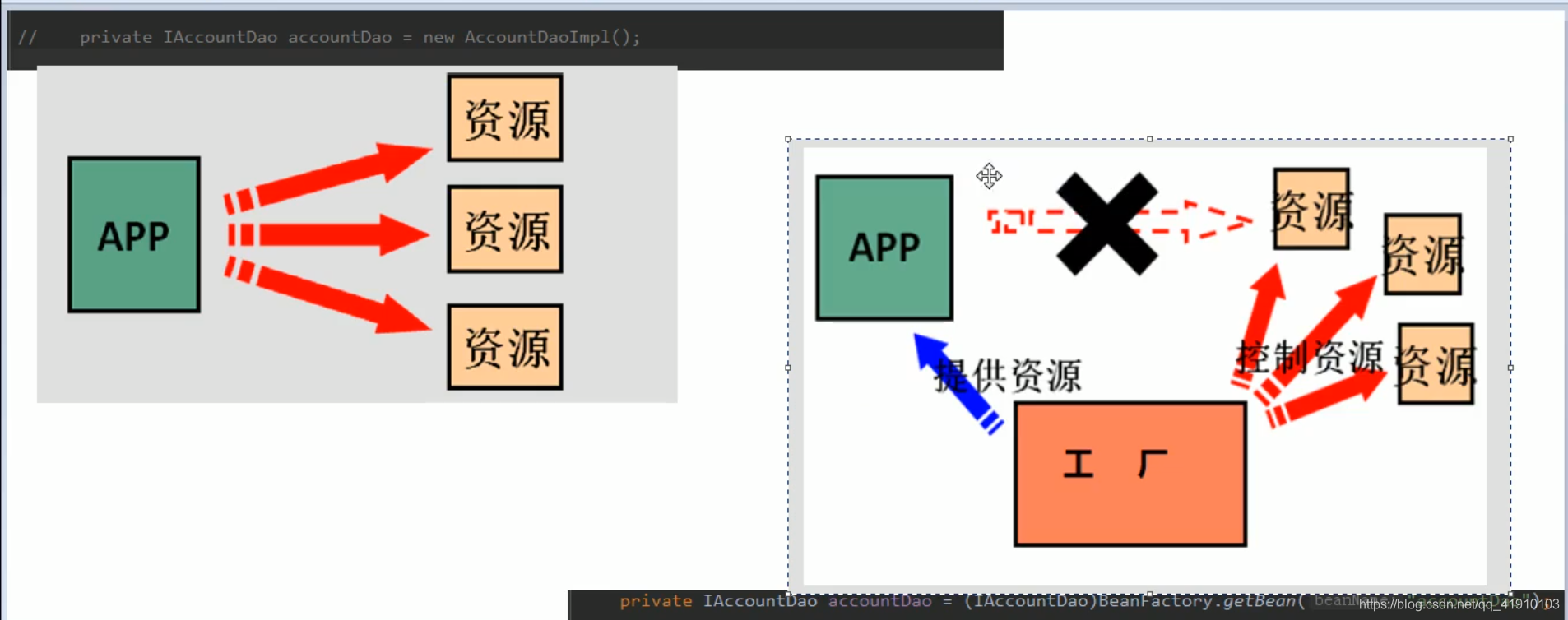时间:2019年5月3日
spring
基础前言(理解IOC含义)
1.关于耦合
package com.iteima.jdbc;
import java.sql.Connection;
import java.sql.DriverManager;
import java.sql.PreparedStatement;
import java.sql.ResultSet;
/**
* 程序的耦合
* 耦合:程序间的依赖关系
* 包括:
* 类之间的依赖
* 方法间的依赖
* 解耦:
* 降低程序间的依赖关系
* 实际开发中:
* 应该做到:编译期不依赖,运行时才依赖。
* 解耦的思路:
* 第一步:使用反射来创建对象,而避免使用new关键字。
* 第二步:通过读取配置文件来获取要创建的对象全限定类名
*
*/
public class JdbcDemo1 {
public static void main(String[] args) throws Exception{
//1.注册驱动
// DriverManager.registerDriver(new com.mysql.jdbc.Driver()); //使用new来创建会在编译前进行依赖
Class.forName("com.mysql.jdbc.Driver"); //利用反射来创建对象 不过此处的字符串已经写死了 需要用读取配置文件的方法来获取对象全限定的类名
//2.获取连接
Connection conn = DriverManager.getConnection("jdbc:mysql://localhost:3306/eesy","root","1234");
//3.获取操作数据库的预处理对象
PreparedStatement pstm = conn.prepareStatement("select * from account");
//4.执行SQL,得到结果集
ResultSet rs = pstm.executeQuery();
//5.遍历结果集
while(rs.next()){
System.out.println(rs.getString("name"));
}
//6.释放资源
rs.close();
pstm.close();
conn.close();
}
}
2.bean(工厂模式)
此代码实现的是单例,通过map的形式(也可以说是容器)
通过一个key 配置文件中的唯一标识accountDao
value 配置文件中的全限定类名
因此在获取的时候只需要要拿就行 而不需要去反复创建了
同时也降低了程序间的耦合性(没有使用new 关键字 取而代之的是工厂 创建对象)
import java.io.InputStream;
import java.util.Enumeration;
import java.util.HashMap;
import java.util.Map;
import java.util.Properties;
/**
* 一个创建Bean对象的工厂
*
* Bean:在计算机英语中,有可重用组件的含义。
* JavaBean:用java语言编写的可重用组件。
* javabean > 实体类
*
* 它就是创建我们的service和dao对象的。
*
* 第一个:需要一个配置文件来配置我们的service和dao
* 配置的内容:唯一标识=全限定类名(key=value)
* 第二个:通过读取配置文件中配置的内容,反射创建对象
*
* 我的配置文件可以是xml也可以是properties
*/
public class BeanFactory {
//定义一个Properties对象
private static Properties props;
//定义一个Map,用于存放我们要创建的对象。我们把它称之为容器
private static Map<String,Object> beans;
//使用静态代码块为Properties对象赋值
static {
try {
//实例化对象
props = new Properties();
//获取properties文件的流对象
InputStream in = BeanFactory.class.getClassLoader().getResourceAsStream("bean.properties");
props.load(in);
//实例化容器
beans = new HashMap<String,Object>();
//取出配置文件中所有的Key
Enumeration keys = props.keys();
//遍历枚举
while (keys.hasMoreElements()){
//取出每个Key
String key = keys.nextElement().toString();
//根据key获取value
String beanPath = props.getProperty(key);
//反射创建对象
Object value = Class.forName(beanPath).newInstance();
//把key和value存入容器中
beans.put(key,value);
}
}catch(Exception e){
throw new ExceptionInInitializerError("初始化properties失败!");
}
}
/**
* 根据bean的名称获取对象
* @param beanName
* @return
*/
public static Object getBean(String beanName){
return beans.get(beanName);
}
/**
* 根据Bean的名称获取bean对象
* @param beanName
* @return
public static Object getBean(String beanName){
Object bean = null;
try {
String beanPath = props.getProperty(beanName);
// System.out.println(beanPath);
bean = Class.forName(beanPath).newInstance();//每次都会调用默认构造函数创建对象
}catch (Exception e){
e.printStackTrace();
}
return bean;
}*/
}
3.IOC(控制反转)
控制权交给了工厂(作用:降低耦合)

spring中的IOC
一丶基于xml
1.依赖注入
<dependencies>
<dependency>
<groupId>org.springframework</groupId>
<artifactId>spring-context</artifactId>
<version>5.0.2.RELEASE</version>
</dependency>
</dependencies>
2.bean.xml
<?xml version="1.0" encoding="UTF-8"?>
<beans xmlns="http://www.springframework.org/schema/beans"
xmlns:xsi="http://www.w3.org/2001/XMLSchema-instance"
xsi:schemaLocation="http://www.springframework.org/schema/beans
http://www.springframework.org/schema/beans/spring-beans.xsd">
<!--把对象的创建交给spring来管理-->
<bean id="accountService" class="com.itheima.service.impl.AccountServiceImpl"></bean>
<bean id="accountDao" class="com.itheima.dao.impl.AccountDaoImpl"></bean>
</beans>
3.实现类
import com.itheima.dao.IAccountDao;
import com.itheima.service.IAccountService;
import org.springframework.context.ApplicationContext;
import org.springframework.context.support.ClassPathXmlApplicationContext;
/**
* 模拟一个表现层,用于调用业务层
*/
public class Client {
/**
* 获取spring的Ioc核心容器,并根据id获取对象
*
* ApplicationContext的三个常用实现类:
* ClassPathXmlApplicationContext:它可以加载类路径下的配置文件,要求配置文件必须在类路径下。不在的话,加载不了。(更常用)
* FileSystemXmlApplicationContext:它可以加载磁盘任意路径下的配置文件(必须有访问权限)
*
* AnnotationConfigApplicationContext:它是用于读取注解创建容器的,是明天的内容。
*
* 核心容器的两个接口引发出的问题:
* ApplicationContext: 单例对象适用 采用此接口(用的更多)
* 它在构建核心容器时,创建对象采取的策略是采用立即加载的方式。也就是说,只要一读取完配置文件马上就创建配置文件中配置的对象。
*
* BeanFactory: 多例对象使用
* 它在构建核心容器时,创建对象采取的策略是采用延迟加载的方式。也就是说,什么时候根据id获取对象了,什么时候才真正的创建对象。
* @param args
*/
public static void main(String[] args) {
//1.获取核心容器对象
ApplicationContext ac = new ClassPathXmlApplicationContext("bean.xml");
// ApplicationContext ac = new FileSystemXmlApplicationContext("C:\\Users\\zhy\\Desktop\\bean.xml");
//2.根据id获取Bean对象 两种方法
IAccountService as = (IAccountService)ac.getBean("accountService");
IAccountDao adao = ac.getBean("accountDao",IAccountDao.class);
System.out.println(as);
System.out.println(adao);
as.saveAccount();
//--------BeanFactory----------
// Resource resource = new ClassPathResource("bean.xml");
// BeanFactory factory = new XmlBeanFactory(resource);
// IAccountService as = (IAccountService)factory.getBean("accountService");
// System.out.println(as);
}
}
4.spring中bean的细节
<?xml version="1.0" encoding="UTF-8"?>
<beans xmlns="http://www.springframework.org/schema/beans"
xmlns:xsi="http://www.w3.org/2001/XMLSchema-instance"
xsi:schemaLocation="http://www.springframework.org/schema/beans
http://www.springframework.org/schema/beans/spring-beans.xsd">
<!--把对象的创建交给spring来管理-->
<!--spring对bean的管理细节
1.创建bean的三种方式
2.bean对象的作用范围
3.bean对象的生命周期
-->
<!--创建Bean的三种方式 -->
<!-- 第一种方式:使用默认构造函数创建。
在spring的配置文件中使用bean标签,配以id和class属性之后,且没有其他属性和标签时。
采用的就是默认构造函数创建bean对象,此时如果类中没有默认构造函数,则对象无法创建。
<bean id="accountService" class="com.itheima.service.impl.AccountServiceImpl"></bean>
-->
<!-- 第二种方式: 使用普通工厂中的方法创建对象(使用某个类中的方法创建对象,并存入spring容器)
<bean id="instanceFactory" class="com.itheima.factory.InstanceFactory"></bean>
<bean id="accountService" factory-bean="instanceFactory" factory-method="getAccountService"></bean>
-->
<!-- 第三种方式:使用工厂中的静态方法创建对象(使用某个类中的静态方法创建对象,并存入spring容器)
<bean id="accountService" class="com.itheima.factory.StaticFactory" factory-method="getAccountService"></bean>
-->
<!-- bean的作用范围调整
bean标签的scope属性:
作用:用于指定bean的作用范围
取值: 常用的就是单例的和多例的
singleton:单例的(默认值)
prototype:多例的
request:作用于web应用的请求范围
session:作用于web应用的会话范围
global-session:作用于集群环境的会话范围(全局会话范围),当不是集群环境时,它就是session
<bean id="accountService" class="com.itheima.service.impl.AccountServiceImpl" scope="prototype"></bean>
-->
<!-- bean对象的生命周期
单例对象
出生:当容器创建时对象出生
活着:只要容器还在,对象一直活着
死亡:容器销毁,对象消亡
总结:单例对象的生命周期和容器相同
多例对象
出生:当我们使用对象时spring框架为我们创建
活着:对象只要是在使用过程中就一直活着。
死亡:当对象长时间不用,且没有别的对象引用时,由Java的垃圾回收器回收
-->
<bean id="accountService" class="com.itheima.service.impl.AccountServiceImpl"
scope="prototype" init-method="init" destroy-method="destroy"></bean>
</beans>
模拟一个工厂类(该类可能是存在于jar包中的,我们无法通过修改源码的方式来提供默认构造函数)
import com.itheima.service.IAccountService;
import com.itheima.service.impl.AccountServiceImpl;
/**
* 模拟一个工厂类(该类可能是存在于jar包中的,我们无法通过修改源码的方式来提供默认构造函数)
*/
public class InstanceFactory {
public IAccountService getAccountService(){
return new AccountServiceImpl();
}
}
import com.itheima.service.IAccountService;
import com.itheima.service.impl.AccountServiceImpl;
/**
* 模拟一个工厂类(该类可能是存在于jar包中的,我们无法通过修改源码的方式来提供默认构造函数)
*/
public class StaticFactory {
public static IAccountService getAccountService(){
return new AccountServiceImpl();
}
}